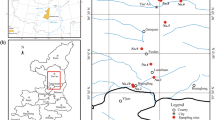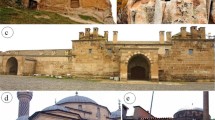Abstract
Salt weathering leads to destruction of many valuable cultural heritage monuments and porous building material. The present study aims at providing more laboratory evidence for evaluating the effects of salt precipitation on the deterioration process. In view of this, the remoulded soil specimens were mixed with three kinds of salts (i.e., NaCl, Na2SO4 and their mixture) with different salt concentrations, and the specimens were kept in environment cabinet for undergoing different wet-dry cycles. After each cycle, the ultrasound velocity measurements were employed to monitor the deterioration process. For the specimens that have suffered three wet-dry cycles, the mechanical properties (i.e. shear strength and compression strength) were determined to evaluate the degree of deterioration. Furthermore, considering the realistic conservation environment of earthen sites, mechanical stability of these specimens against sediment-carrying wind erosion was conducted in a wind tunnel. These experiments results indicate that the overall average velocities of the specimens after the third cycle are significantly lower than those subjected to only one cycle. Ultrasound velocity, mechanical strength and wind erosion rate decrease when salt content increases. However, the internal friction angle increases firstly, and then decreases with the increase in salt content added to the specimens. Na2SO4 contributes most of the surface deterioration, while NaCl plays little role in the deterioration. The damage potential of the salt mixture is less obvious and largely dependent on the crystallisation location.
Similar content being viewed by others
References
BARTON J. 3D laser scanning and the conservation of earthen architecture: A case study at the UNESCO World Heritage Site Merv, Turkmenistan [J]. World Archaeology, 2009, 41: 489–504.
SHAO Ming-shen, LI Li, WANG Si-jing, WANG En-zhi, LI Zui-xiong. Deterioration mechanisms of building materials of Jiaohe ruins in China [J]. Journal of Cultural Heritage, 2013, 14: 38–44.
FUJII Y, FODDE E, WATANABE K, MURAKAMI K. Digital photogrammetry for the documentation of structural damage in earthen archaeological sites: The case of Ajina Tepa, Tajikistan [J]. Engineering Geology, 2009, 105: 124–133
ZHAO Hai-ying, LI Zui-xiong, HAN Wen-feng, WANG Xu-dong, CHEN Wen-wu. Main diseases and their causes of earthen ruins in arid region of northwestern China [J]. Chinese Journal of Rock Mechanics and Engineering, 2003, 22(2): 2875–2880. (in Chinese)
FODDE E. Structural faults in earthen archaeological sites in Central Asia: Analysis and repair methods [C]// The Sixth International Conference on Structural Analysis of Historic Construction. London: Taylor & Francis, 2008: 1415–1422.
GOUDIE A, VILES H. Salt weathering hazards [M]. Chichester: John Wiley & Sons, 1997.
SCHERER G W. Crystallisation in pores [J]. Cement and Concrete Research, 1999, 29: 1347–1358.
FLATT R J. Salt damage in porous materials: How high supersaturations are generated [J]. Journal of Crystal Growth, 2002, 242: 435–454.
PU Tian-biao, CHEN Wen-wu, LV Hai-min, DU Yu-min. Analysis on function of deterioration of typical earthen ruins under the coupling of salinized and freezing and thawing in Qinghai–Tibet Plateau [J]. Journal of Central South University: Science and Technology, 2016, 47(4): 1420–1426. (in Chinese)
LAVALLE J. Research on the slow formation of crystals at ordinary temperature [J]. Compte Rend Acad Sci(Paris), 1853, 36: 493–495. (in French)
ANGELI M, BIGAS J P, BENAVENTE D, MENENDEZ B, HEBERT R, DAVID C. Salt crystallization in pores: Quantification and estimation of damage [J]. Environmental Geology, 2007, 52(2): 205–213.
BENAVENTE D, MA G D C. Durability estimation of porous building stones from pore structure and strength [J]. Engineering Geology, 2004, 74(1): 113–127.
CORRENS C W. Growth and dissolution of crystals under linear pressure [J]. Discuss Faraday Soc, 1949, 5(5): 267–271.
MORI R. Some problems on the chemical stability of soils [R]. Tokyo: Committee of Soil Chemistry, Association of Electrochemistry, 1964.
STEIGER M, KIEKBUSCH J, NICOLAI A. An improved model incorporating Pitzer’s equations for calculation of thermodynamic properties of pore solutions implemented into an efficient program code [J]. Construction and Building Materials, 2008, 22: 1841–1850.
LIN Qing-tao. Research on the survey and distribution of salt in the wall of Suoyang ruins in Gansu Province [D]. Lanzhou: Lanzhou University, 2010. (in Chinese)
HUANG Si-ping, LI Yu-hu, ZHAO Yu-jie. Preliminary study on migration of soluble salts in simulated earthen site [J]. Journal of Shaanxi Normal University: Natural Science Edition, 2010, 38 (5): 51–55. (in Chinese)
CUI Kai, CHEN Wen-wu, SHEN Yun-xia, WANG Xu-dong, HAN Wen-feng. Experimental study on response of intensity on earthern ruin’s soil undergoing recombination process of salinized and dry-wet in arid and semi-arid regions [J]. Journal of Central South University: Science and Technology, 2012, 43(11): 4451–4456. (in Chinese)
RODRIGUESZ-NAVARRO C, DOEHNE E. Salt weathering: influence of evaporation rate, supersaturation and crystallisation pattern [J]. Earth Surf Process Landforms, 1999, 24: 191–209.
TSUI N, FLATT R J, SCHERER G W. Crystallisation damage by sodium sulfate [J]. Journal of Cultural Heritage, 2003, 4: 109–115.
LINNOW K, JULING H, STEIGER M. Investigation of NaCl deliquescence in porous substrates using RH-XRD [J]. Environmental Geology, 2007, 52: 317–327.
ESPINOSA-MARZAL R M, SCHERER G W. Crystallisation of sodium sulfate salts in limestone [J]. Environmental Geology, 2008, 56: 605–621.
STEIGER M, ASMUSSEN S. Crystallisation of sodium sulfate phases in porous materials: The phase diagram Na2SO4-H2O and the generation of stress [J]. Geochimica et Cosmochimica Acta, 2008, 72: 4291–4306.
SAIDOV T, PEL L, van der HEIJDEN G. Crystallisation of sodium sulfate in porous media by drying at a constant temperature [J]. International Journal of Heat and Mass Transfer, 2015, 83: 621–628.
CHEN Wen-wu, LV Hai-min, CUI Kai, WU Guo-peng, DU Yu-min. Comparative study of the influence of chlorine and sulfate slat on grain size distribution and limit moisture content in site soils [J]. Journal of Lanzhou University: Natural Science, 2015, 51(3): 334–338. (in Chinese)
CHEN Yu, WANG Xu-dong, YANG Shan-long, GUO Qing-lin, LIN Bo, LI Feng-jie. A preliminary study of the freeze-thaw cycle on the structure of earthen sites with different salts [J]. Dunhuang Research, 2013(1): 98–107. (in Chinese)
CHEN Wei-tao, LI Shu, WANG Ying. Influence of shearing strength of salt-bearing-soil from salt content and salt sort [J]. Railway Construction Technology, 2005(6): 54–56. (in Chinese)
GROSSI C M, ESBERT R, del RIO L S, MONTOTO M, LAURENZI-TABASSO M. Acoustic emission monitoring to study sodium sulphate crystallisation in monumental porous carbonate stones [J]. Studies in Conservation, 1997, 42: 115–125.
GB/T50123—1999. Standard for soil test method. (in Chinese)
MOORE D M, REYNOLDS R C. X-ray Diffraction and the identification and analysis of clay minerals [M]. Oxford: Oxford University Press, 1989.
JIANG Yao, CHEN Wen-wu, WANG Gong-hui, SUN Guan-ping, ZHANG Fan-yu. Influence of initial dry density and water content on the soil–water characteristic curve and suction stress of a reconstituted loess soil [EB/OL]. [2016–05–13]. http://link.springer. com/article/10.1007/s10064-016-0899-x.
KAHRAMAN S. Estimating the direct P-wave velocity value of intact rock from indirect laboratory measurements [J]. International Journal of Rock Mechanics and Mining Sciences, 2002, 39: 101–104.
ZHANG J, SHAO Y, HUANG N. Measurements of dust deposition velocity in a wind-tunnel experiment [J]. Atmospheric Chemistry and Physics, 2014, 14: 8869–8882.
CHEPIL W. Factors that influence clod structure and erodibility of soil by wind: IV. sand, silt, and clay [J]. Soil Science, 1955, 80: 155–162.
VAN PELT R S, ZOBECK T M. Validation of the wind erosion equation (WEQ) for discrete periods [J]. Environmental Modelling & Software, 2004, 19: 199–203.
HAN Lin. Experiment research on the destroyed mechanism of the saline soil in the Great Wall in Shandan County [D]. Lanzhou: Lanzhou University, 2010. (in Chinese)
CHEPIL W. Properties of soil which influence wind erosion: V. Mechanical stability of structure [J]. Soil Science, 1951, 72: 465–478.
HAMILTON A, HALL C, PEL L. Sodium sulfate heptahydrate: direct observation of crystallisation in a porous material [J]. Journal of Physics D: Applied Physics, 2008, 41: 212002.
SCHIRO M, RUIZ-AGUDO E, RODRIGUEZ-NAVARRO C. Damage mechanisms of porous materials due to in-pore salt crystallization [J]. Physical Review Letters, 2012, 109: 265503.
STEIGER M. Crystal growth in porous materials—I: the crystallisation pressure of large crystals [J]. Journal of Crystal Growth, 2005, 282: 455–469.
SHAHIDZADEH N, DESARNAUD J. Damage in porous media: role of the kinetics of salt (re) crystallization [J]. The European Physical Journal Applied Physics, 2012, 60: 24205.
DESARNAUD J, BERTRAND F, SHAHIDZADEH-BONN N. Impact of the kinetics of salt crystallisation on stone damage during rewetting/drying and humidity cycling [J]. Journal of Applied Mechanics, 2013, 80: 020911.
BARBOUR S, FREDLUND D. Mechanisms of osmotic flow and volume change in clay soils [J]. Canadian Geotechnical Journal, 1989, 26: 551–562.
MITCHELL J K, SOGA K. Fundamentals of Soil Behavior [M]. 3rd ed., Hoboken, New Jersey: John Wiley& Sons, 2005.
BJERRUM L. Progressive failure in slopes of over consolidated plastic clay and clay shales [C]// Terzaghi Lectures. ASCE, 1967: 77–78.
ZHANG Hu-yuan, YAN Geng-sheng, ZHAO Tian-yu. Durability of earthen architecture ruins under cyclic wetting and drying [J]. Rock and Soil Mechanics, 2011, 32(2): 347–355. (in Chinese)
Acknowledgement
We appreciate to Dr Michael Steiger for his generous help on the calculation of phase diagram of the Na2SO4−NaCl−H2O system. We are also grateful to wind tunnel laboratory technicians for preparing experiment instruments. The authors want to thank all the members who helped us and cooperated with us.
Author information
Authors and Affiliations
Corresponding author
Additional information
Foundation item: Projects(2010BAK67B16, 2013BAK08B11, 2014BAK16B02) supported by the National Science and Technology Support Program of China during the 12th Five-year Plan Period
Rights and permissions
About this article
Cite this article
Shen, Yx., Chen, Ww., Kuang, J. et al. Effect of salts on earthen materials deterioration after humidity cycling. J. Cent. South Univ. 24, 796–806 (2017). https://doi.org/10.1007/s11771-017-3482-0
Received:
Accepted:
Published:
Issue Date:
DOI: https://doi.org/10.1007/s11771-017-3482-0




